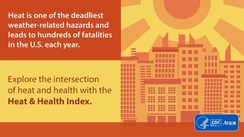The U.S. Department of Health and Human Services (HHS) recently launched a new tool to help communities prepare for heat and prevent heat-related illness and death.
Source: HUD Healthy Homes email newsletter
The Heat and Health Index (HHI) is a national tool that incorporates historical temperature, heat-related illness, and community characteristics data at the ZIP code level to identify areas most likely to experience negative health outcomes from heat and help communities prepare for heat in a changing climate. Each ZIP code has a single ranking for the overall HHI and rankings for individual components so that users can make informed decisions to prepare for and prevent the negative health impacts of heat in their communities.
By working at the community-level to build resilience, this tool will help lessen the health impacts of heat on our communities at greatest risk:
- Public health officials, city planners, and policymakers will now be able to identify and prioritize areas most at risk across the country and help prepare these communities to reduce heat-related illness and death.
- Health care providers can plan for an uptick in patients at local hospitals.
- City planners can use the HHI to identify the ZIP codes that would benefit the most from heat mitigation strategies, like increased tree canopy cover, increased access to air conditioning, or cool roofs.
Users can access the HHI by visiting the CDC’s Heat and Health Tracker website and clicking on “Heat and Health Index” (HHI) in the left navigation menu. lick to edit this placeholder text.
More Information:
CDC and NOAA Launch the Nation’s First Health-Based Heat Forecast and Clinical Guidance
The CDC, in partnership with the National Oceanic and Atmospheric Administration’s (NOAA), released the nation’s first health-based heat alert system and heat guidance for clinicians. The release includes the following three resources:
- The HeatRisk Forecast Tool, developed by CDC and NOAA, provides a seven-day heat forecast that tells you when temperatures are predicted to reach levels that could harm health.
- CDC’s HeatRisk Dashboard is a portal with new resources that include the HeatRisk Forecast Tool, details on local air quality, and actions to stay safe on hot days or days with poor air quality.
- CDC clinical guidance will help clinicians create plans with their patients to keep at-risk individuals, such as children with asthma, pregnant women, and people with cardiovascular disease, safe when temperatures rise and may cause negative health impacts.
More than two-thirds of all Americans were under heat alerts in 2023. Daily emergency department visits because of heat-related illness in 2023 peaked in several regions over the warm-season months and, in those regions, remained exceedingly high for an extended duration. Heat can cause heat related deaths and illness, like heat exhaustion and heat stroke. In addition, heat can worsen underlying health conditions.






